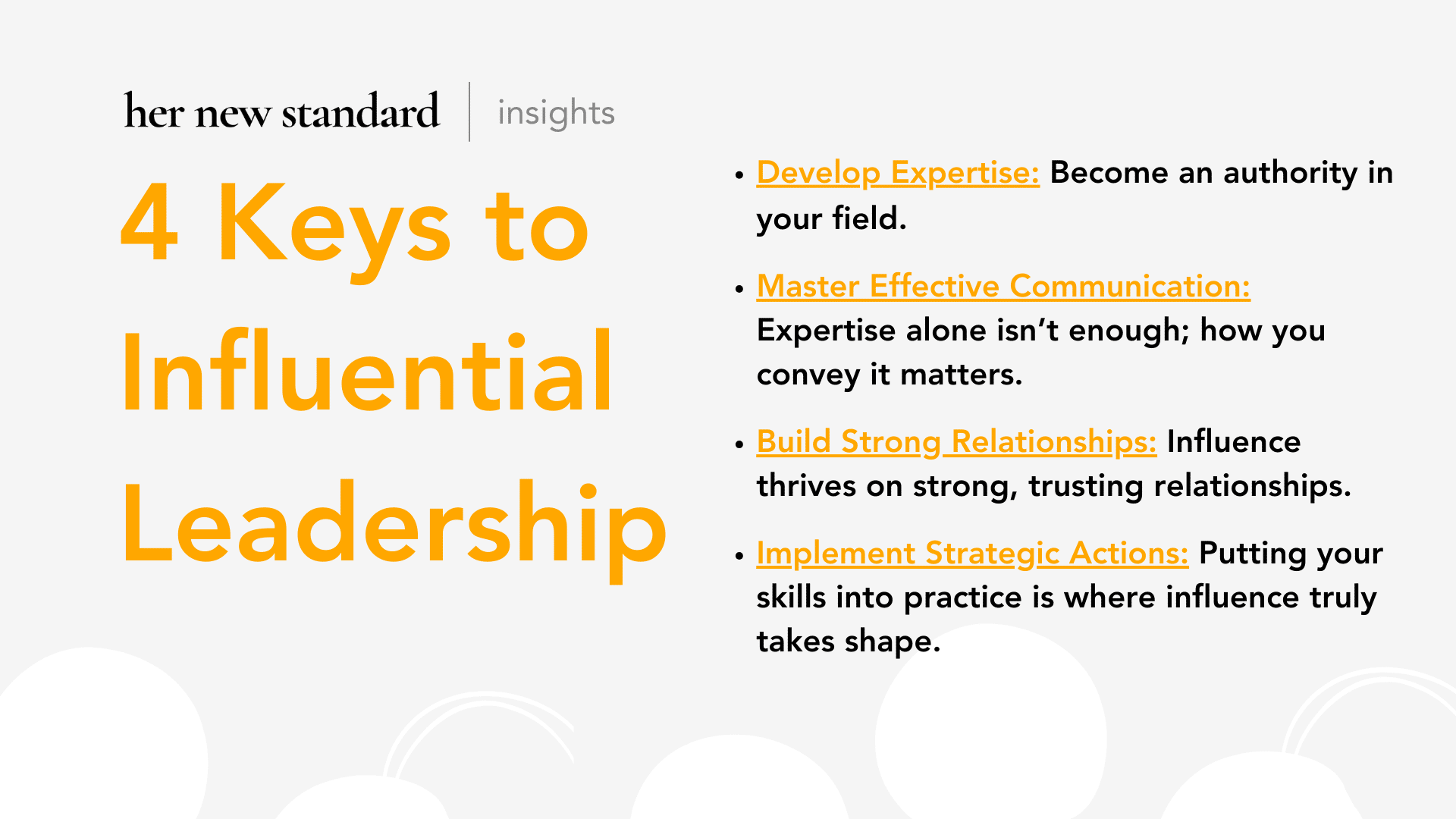In boardrooms and beyond, a quiet yet transformative shift is occurring—one that redefines leadership not by rank but by resonance. Imagine a leader whose impact isn’t measured by the volume of their voice or the weight of their title, but by the subtle, almost imperceptible ways they shift the fabric of their organization.
At Her New Standard, we have the privilege of witnessing this powerful evolution firsthand, particularly in women leaders. There is no textbook that captures the essence of turning latent potential into palpable influence, no training manual that charts this path.
While many leaders gain recognition through their titles, the most effective ones are those who create deep, resonant influence within their organizations and communities. We see women leaders, in particular, converting their potential into meaningful, lasting impact. So how do we develop such influence? How can women apply their talents to catapult results and drive meaningful progress?
Understanding Influential Leadership
Influential leadership is more than just a concept; it’s a practice that relies on personal credibility, emotional intelligence, and genuine connection. Unlike authority-based leadership, which relies on hierarchical power, influential leadership focuses on inspiring and guiding others through respect and persuasion.
– Robin Sharma
Influential Leadership vs. Positional Authority
This chart highlights the key differences between influential leadership and positional authority, and shows how each impacts leadership and organizational success.
| Influential Leadership | Positional Authority | |
| Power Source | Personal credibility, emotional intelligence, expertise | Formal position, hierarchical power |
| Approach | Inspires through respect and persuasion | Commands through rules and directives |
| Communication | Open, interactive, seeks feedback | Top-down, directive, and formal |
| Impact & Long-Term Effect | Builds sustainable growth, fosters trust and high morale | Short-term compliance, can lead to dissatisfaction |
Cultivating Leadership Impact: Essential Skills and Strategies
Let’s explore how you can make a meaningful impact and lead effectively, even without a formal title. Leadership isn’t defined by a position but by honing the right skills and implementing strategic approaches.
Here’s how you can cultivate your leadership abilities, regardless of your role:
1. Develop Expertise
First things first: become an authority in your field. Deeply understanding your discipline or industry not only positions you as a go-to resource but also lends credibility to your ideas and projects.
For instance, in biotech, a leader might focus on earning advanced degrees and certifications in genetic research or regulatory affairs, stay updated on the latest breakthroughs, and actively participate in industry conferences.
Sharing your research findings or innovative approaches through internal reports or scientific journals can further establish you as a trusted expert within your organization.
2. Master Effective Communication
Expertise alone isn’t enough; how you convey it matters. Articulating your vision in a clear and compelling manner can motivate and inspire your team.
A manager leading a new software development project might use storytelling to connect the project’s goals with the team’s technical interests and the company’s strategic objectives.
Regularly engaging in open dialogue and tailoring your communication to suit different audiences, from developers to senior management, will enhance your influence and effectiveness.
3. Build Strong Relationships
Influence thrives on strong, trusting relationships. It’s crucial to build connections with peers and senior leaders across different areas of the company to gain the information and resources needed to solve problems and drive innovation.
Often, we stay within our own departments—like an equity researcher who may not know anyone in finance or IT. But to implement a new technology that showcases their scientific expertise, they’d benefit from knowing someone in Finance who can support the budget request and an IT expert to ensure seamless integration with existing platforms.
By building these relationships, they can navigate the internal network more effectively and expedite the process, turning innovative ideas into reality.
4. Implement Strategic Actions
Putting your skills into practice is where influence truly takes shape. Set clear, achievable goals aligned with your organization’s broader objectives and involve your team in the planning process to ensure buy-in.
Take, for instance, an equity researcher who identifies a groundbreaking financial model developed by a startup. Recognizing its potential to revolutionize their business, she must articulate how this new technology aligns with the firm’s broader strategy, detailing both the short-term and long-term benefits.
By clearly connecting the dots between the innovation and its impact on the bottom line, she can effectively advocate for its implementation and guide the strategy’s rollout.
By integrating these skills and strategies into your daily interactions, you can become a more influential leader, making a significant impact even without a formal title.

HNS Co-founder Ellen Keithline Byrne’s
Influence Strategy at
Save the Children
Ellen Keithline Byrne’s experience at Save the Children illustrates how true influence in leadership goes beyond titles and authority. In this piece, Ellen recounts her journey of identifying a critical need, crafting a solution, and strategically building relationships to implement a transformative program. Her story highlights the essence of impactful leadership through genuine connection and strategic influence:

Highlighting My Expertise
Beyond my job description, I looked at my unique skills and how I could apply them. I was trained in mental health counseling, and I noticed that Save the Children employees had pressing needs. I saw passionate, hardworking humanitarian workers returning from deployments in war zones, natural disasters, and other serious crises involving children, all with serious mental health conditions. At the time, Save the Children didn’t have systems to support these employees.Solution to the Problem
I discussed my concerns and ideas with my manager, who encouraged me to develop a support system. Leveraging my background, I designed a global resilience program called “Bounce, Don’t Break: Resilience Training for Humanitarian Staff” to be delivered to all deployed humanitarian workers. The pilot program was highly successful, but now we needed funding to make it a regular offering.Strategic Relationship Building
As a new Associate Director, I had little authority to make it happen, so I had to build my influence. I focused on building relationships with decision-makers and gaining buy-in from key stakeholders.
I started by making sure all the executives knew who I was. When possible, I arrived at work early to overlap with key leaders, greeting them and making small talk. After town halls, I would walk out with them and comment on their presentations.
On my team, I volunteered for projects that involved senior leaders so they would know both me and the quality of my work. Knowing the CEO walked by my desk after lunch, I made a point to say hello and comment on the latest emergency Save the Children was involved in. Over time, we had regular conversations where I could discuss my work.
As the only mental health professional in the organization, I sought the perspective of humanitarian leaders on the issue and shared my initiative. They got excited and offered support.
Although I was based in the US, I needed support from the international headquarters in London. I convinced my manager to let me run a pilot program for “Bounce, Don’t Break” in London and invited executives from the international headquarters.
Impact
After two years, I had built strong relationships with key stakeholders and executives. When I made recommendations or budget requests, they took me seriously. I became known as the resilience expert within Save the Children International and earned respect.
Although I didn’t have the official power or title, I knew who to approach to get things done. I was gaining influence and earned the respect to be listened to seriously. The “Bounce, Don’t Break” program became a staple within Save the Children, impacting many humanitarian workers and strengthening their resilience.
Become a more influential leader with HNS
If you’re serious about transforming your leadership style and making a significant impact, Her New Standard offers a range of programs tailored to support you.
Our programs are designed to help women leaders enhance their leadership capabilities and drive meaningful change within their organizations.
Contact us to learn more about how our programs can promote your growth as an influential leader so you can not only enhance your leadership capabilities but also drive meaningful change within your organization.
Enjoyed this post? You might also like…




